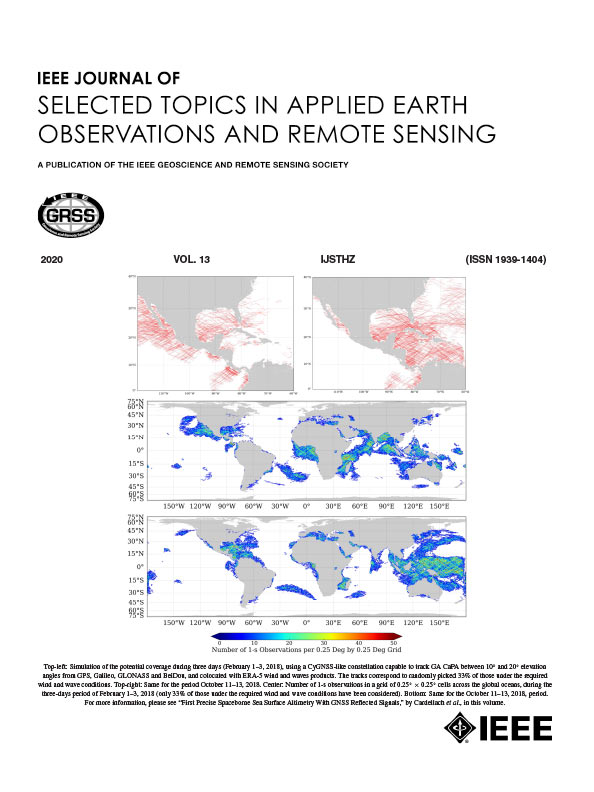基于AIS数据的大尺度SAR图像小目标级联精细检测
IF 5.3
2区 地球科学
Q1 ENGINEERING, ELECTRICAL & ELECTRONIC
IEEE Journal of Selected Topics in Applied Earth Observations and Remote Sensing
Pub Date : 2025-09-19
DOI:10.1109/JSTARS.2025.3612035
引用次数: 0
摘要
大尺度合成孔径雷达(SAR)图像中的小目标由于其微妙的特征和复杂背景的干扰,给小目标的检测带来了很大的挑战。这在识别海上船只时尤其成问题,因为SAR图像通常包含大量地理信息,其中一些陆地特征与船只相似。这些相似性增加了错误检测的可能性,使准确识别和跟踪船只变得复杂。为了解决这些挑战,本文提出了一种级联精细检测方法,用于大规模SAR图像中的小物体,利用自动识别系统(AIS)数据提高精度。具体来说,为了解决大尺度场景下的小目标检测问题,我们设计了一个遥感检测网络(RSDNet),该网络优化了特征提取和多尺度信息融合,以捕获更精细的目标细节。为了最大限度地减少错误检测,AIS数据通过跨模态数据融合作为先验知识嵌入到检测框架中。因此,AIS数据在空间和时间维度上与SAR图像相结合。同时,我们使用三个可公开访问的数据集以及来自遥感目标探测船(RSOD船)的自建数据集验证了RSDNet的准确性。此外,为了评估我们方法的有效性,我们在缺乏AIS和SAR匹配基准数据集的情况下创建了SAR - AIS匹配数据集。最后,大量的实验结果表明,该方法在大尺度SAR图像中的小目标检测方面具有良好的应用前景。本文章由计算机程序翻译,如有差异,请以英文原文为准。
Cascaded Fine Detection of Small Object in Large-Scale SAR Images Leveraging AIS Data
Detecting small objects in large-scale synthetic aperture radar (SAR) images presents significant challenges due to their subtle features and the interference from complex backgrounds. This is particularly problematic when identifying maritime vessels, as SAR imagery often includes extensive geographic information, with some land features resembling vessels. These similarities increase the likelihood of false detections, complicating the accurate identification and tracking of vessels. To address these challenges, this article proposes a cascade fine detection methodology for small objects in large-scale SAR images, leveraging automatic identification system (AIS) data for enhanced accuracy. Specifically, to address the issue of small object detection in large-scale scenes, we design a remote sensing detection network (RSDNet), which optimizes feature extraction and multiscale information fusion to capture more refined object details. To minimize false detections, AIS data is embedded into the detection framework as prior knowledge through cross-modal data fusion. Thus, AIS data is integrated with SAR images in both spatial and temporal dimensions. Meanwhile, we validate RSDNet’s accuracy using three publicly accessible datasets as well as a self-built dataset from a remote sensing object detection vessel (RSOD vessel). Furthermore, to assess the efficacy of our approach, we create a SAR–AIS matching dataset in the absence of a benchmark dataset for AIS and SAR matching. Finally, the extensive experimental results indicate that the proposed methodology can provide promising detection of small objects in large-scale SAR images.
求助全文
通过发布文献求助,成功后即可免费获取论文全文。
去求助
来源期刊
CiteScore
9.30
自引率
10.90%
发文量
563
审稿时长
4.7 months
期刊介绍:
The IEEE Journal of Selected Topics in Applied Earth Observations and Remote Sensing addresses the growing field of applications in Earth observations and remote sensing, and also provides a venue for the rapidly expanding special issues that are being sponsored by the IEEE Geosciences and Remote Sensing Society. The journal draws upon the experience of the highly successful “IEEE Transactions on Geoscience and Remote Sensing” and provide a complementary medium for the wide range of topics in applied earth observations. The ‘Applications’ areas encompasses the societal benefit areas of the Global Earth Observations Systems of Systems (GEOSS) program. Through deliberations over two years, ministers from 50 countries agreed to identify nine areas where Earth observation could positively impact the quality of life and health of their respective countries. Some of these are areas not traditionally addressed in the IEEE context. These include biodiversity, health and climate. Yet it is the skill sets of IEEE members, in areas such as observations, communications, computers, signal processing, standards and ocean engineering, that form the technical underpinnings of GEOSS. Thus, the Journal attracts a broad range of interests that serves both present members in new ways and expands the IEEE visibility into new areas.

 求助内容:
求助内容: 应助结果提醒方式:
应助结果提醒方式:


